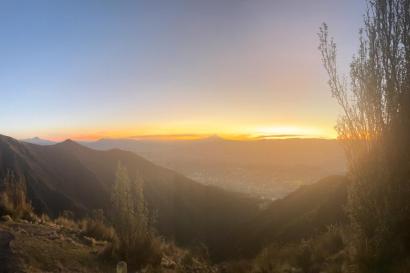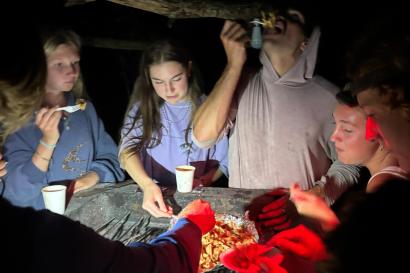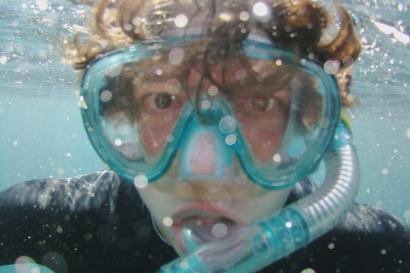(Note** Due to the length of this story, this post will be divided into two parts. You probably gathered that from the title, but thought I’d reiterate.)
Gather around, children. I have a story for you.
Last we talked, if you recall, I told you of my idyllic everyday – the lullaby of tropical surf, a routine of birds, beach, and batidos. Life on the Galapagos was chugging along at a steady, comfortable pace, leaving deep footprints in dark sand.
It is with great sadness that I report this lullaby interrupted. A great wave has swept away our footprints and pulled us out to sea, into the great unknown. We are now floundering in the erratic swells. That’s how it feels, at least, telling this story from my bedroom in Connecticut, facing down several uncertain months and the shattering of a timeline I’d taken for granted until now. Yes, friends, this is the ugly truth of the matter: our semester is, in many ways, over. The fellowship has ended. We have been sent home.
While this situation often devolved too rapidly to really keep up with, it’s been a long time coming. I remember sitting around with my host family in Quito our first week and talking about COVID, a suspected first case in Ecuador – tensions were already high. As a backdrop to everything I’ve written about so far, of course, we were aware of the developments in this situation and were monitoring them closely. Yet for the longest time, as will now become a commonplace anecdote, we figured the crisis would stay far away from us and our adventures. It was only over the past week or so that the magnitude of the crisis became apparent, and things devolved frantically after that.
As of last week, we understood that COVID had come to Ecuador in a real way and that shutdowns were inevitable. In our last week of classes during module three, news broke that many of our home colleges and universities were suspending classes for the semester, and some were requesting students home. As those recalled students bounced back and forth between hard decisions and glued themselves to their inboxes, we all began to hear whispers of internal change. The GAIAS administrators and faculty were in and out of meetings. Cryptic messages were circulated. Finally, the news broke: Ecuador was suspending all classes as well, and we would have to continue the semester online. This declaration canceled all field trips, even our weeklong jaunt to Tiputini in the Ecuadorian Amazon (a major blow), and also necessitated an early departure from the Galapagos. Internet connection at our island homes was lacking, to say the least, and pursuing online classes over that bandwidth was not feasible. So we all gathered together and accepted the hard truth: while we were going to have to adapt to major changes, things would continue back in Quito. We’d still be a largely intact group, and we’d maybe even get to take weekend trips. Additionally, our return to the mainland was still a week away: we had spring break to look forward to. For many of us this involved island hopping, exploration of remote and legendary places, penguins and flamingos. IES Abroad confirmed – our spring break was as intact as we wanted it to be, and for the time being, we were content.
Let’s fast forward 24 hours.
That was Friday. Saturday, our first day of spring break, proceeded as planned. And what a day it was! We left our home in San Cristobal bright and early, bidding our host families a cheery and temporary goodbye, and caught a boat for Floreana Island. Floreana is a smaller, westerly Galapagos Island, but it is rich in history and breathtakingly beautiful – modest cinder cones reclaimed by lush tangles of greenery rise from slushie-colored water and a coastline of lava rock and mangroves. We crossed miles of open water on a sleek vessel with plenty of outdoor seating, spent some quality time with a cooperative Bryde’s Whale (Balaenoptera brydei), and made a slow circumnavigation of a crumbling cinder cone peppered with nesting Nazca Boobies. Once on the island, we bussed up dusty roads to a trail in the highlands where a Tortoise re-introduction program was taking place. The Floreana Giant-Tortoise was one of the few species hunted to extinction in the Galapagos, and an intensive captive breeding program is trying to “re-create” the lost species through a variety of targeted gene transfers. It’s a complicated and revolutionary undertaking, not yet complete, but as we watched the gentle giants munch on the grass in the dappled understory they didn’t seem to mind much. They didn’t really seem to care about their species status or genetic impurities, whatever those may be – life is good in the hills. After a wonderful open-air lunch, we returned to the coast, where some people snorkeled and others lounged on the black-sand beach. The sun was bright overhead and laughter floated on the salty breeze – any global pandemic seemed far away, drowned in passage. After some time we re-boarded our boat and set forth for the day’s final destination: Isabela. The largest of the Galapagos Islands, Isabela is a place of raw, violent beauty—huge moonscape craters, crashing surf – but also famed for its quiet lagoons and palm-studded beaches. In the late daylight, it soon loomed golden on the horizon, surf-spray sparkling metallic upon a rugged coastline. A Tropicbird drifted overhead, loosely kiting in the trade winds.
We pulled into a teal harbor and passed over schools of Cow-nose Rays, small Blacktip Reef Sharks, cruised by flurries of Brown Noddies foraging on the surface. I scanned the rocks incessantly, looking for an igneous lump that wasn’t, and as we moored in waiting for the water taxi my searching paid off. A Galapagos Penguin, my first wild penguin ever, laid lazily in front of some red mangrove roots off the starboard side. Bird #1030. Smoky gray and splotchy like mud-spatter, the penguin stretched out its paddled flippers and stood up to preen. I passed my binoculars around so everyone could get a look – a penguin! A wild penguin, just shy of the equator!
At about this moment, things changed. We had been away from cell service all day but now, pulling into the cradle of the town, phones started to buzz and ding incessantly—what could possibly be the matter?
Word spread like wildfire from the bottom to the top deck. Ecuador was instituting a travel ban, effective Monday night. The Galapagos were closing. IES Abroad and GAIAS had confirmed with us, here as we bobbed in the gentle sway of the South Pacific: we had to get out. We had to go home. It was over.
To shore then, at least for now, we piled uncertainly into a blue and yellow water-taxi with its paint chipping. We unloaded our bags on the dock; stood listlessly in disbelief as phone calls were made and intense conversations unfolded. The air rich with confusion, the breeze off the water dispersing it like pollen, we soon found out the preliminary plan: we were to stay in our hotel that night and prepare for an early evacuation to the airport the next morning. There would be no goodbye to our host families, no return to our rooms on Sa Cristobal – our stuff would be packed up and shipped to meet us at Baltra airport in the morning. It was a hail-mary plan with little wiggle room. The islands were closing. There was no better option.
The night passed dreamlike, holding onto us until the early hours of the morning. Several of us wandered the sandy cobbled streets of town as the last flush of color swelled above the palms, making our way down to a lagoon where an American Flamingo stood illuminated in a nearby streetlight (#1031). After a hurried dinner, people drifting in and out to the street to take and make calls, we ate ice cream at the edge of the park. Venus blew kisses overhead as the last traces of indigo faded black. Later, on the beach, the milky way meandered overhead as we lay back on the sand and listened to the waves. Moonlit foam washed up and down the sand, the silhouettes of Sanderlings tailing the edges of reflection. The night was still, the moon unwavering, and we stayed close to each other in the monochromatic dark.
There was a storm coming, we knew, but in those final moments, everything was perfectly calm. Dawn, and evacuation, would come too soon.
(To be continued)

Brendan Murtha
<p>Hi everyone! My name is Brendan, and I'm a junior at Bowdoin College (Brunswick, ME) studying Ecology, Evolution, and Marine Biology. I'm passionate and curious about all things natural history related, and although my main focus has always been birds, I am just as likely to be found photographing dragonflies or catching snakes as I am craning my neck to look at the skies. These interests have also led me down paths of human ecology, conservation, and all things political, and I enjoy exploring such topics in my writing, photography, and music. I'm super excited to be part of the GAIAS program this semester, and hope to capture some of the magic through my posts.</p>








